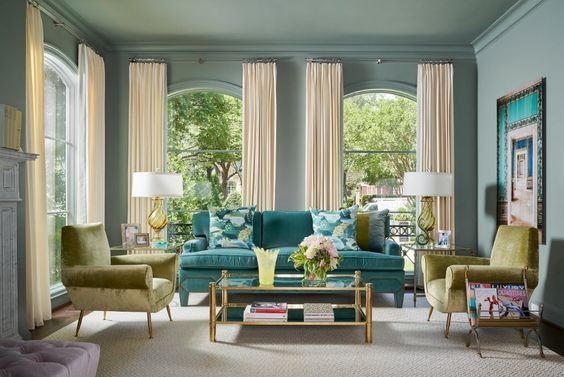Monochromatic interiors - what to do and what to avoid
Photo : Jan Showers
Monochromatic interior styles are extremely popular, they create a sense of elegance and sophistication in many homes. For homeowners seeking a minimal approach to design and who desire to express their unique style in a luxurious yet very straightforward way, monochrome is the way to go.
If you’re interested in this color palette and style or want to achieve a monochromatic-inspired aesthetic, then there are a few do’s and don’ts that we recommend knowing beforehand!
In this blog, we are covering all of the tips and tricks for pulling off a successful monochromatic design in your home.
What is monochromatic design?
A monochromatic design is focused on the color scheme. It is a one-color scheme that is created using different tones of that one color. Once you have chosen your base color, you can use a color wheel to help you choose different hues of that same color. You can also select various “tones” which are defined as the lightness or darkness of a color or hue.
Choose your base color
This is the most important step, your base color will be what you build upon as you create your design. You’ll then use varying tones of your base color to pull off a cohesive look. An example could be that your base color is black. Different saturations, hues, and tones of black would then be used throughout your design, filtering into your furniture, furnishings, accessories, and lighting. Since the color you choose will set the tone of your entire design, it’s important to choose a shade that suits your personal style. If you’re new to this design, or you’re not 100% certain of your desired color palette, we recommend easing your way in with softer, more neutral colors. Start by working with more neutral tones such as grey, black, brown, and white.
Be courageous, be bold
Remember, there are no hard and fast rules in the world of design. If you have a little more adventurous spirit, we love going all in with various tones of a single hue on every surface in the room. Think walls, ceiling, fabrics… everything! Need some help choosing your color? Take a look in your closet and see what color appears most often. This will be the color you likely look and feel best in your surroundings.
Don’t fight the light
It’s important to take note of the natural lighting in the space and try not to force a light room to be dark, or vice versa. Instead, take Mother Nature’s lead!
Texture is king
For those who have less design experience or awareness of monochromatic color palettes, it can be tempting to choose just one tone of color or material and stick with it throughout the entirety of the design. A lack of variety in tone and shade will make the design appear flat and dull.
We suggest using a variety of materials to help create more visual interest, depth, and contrast. For example, if you are using neutrals, select a slick marble for your countertops and a rough stacked stone or lime-washed brick for your fireplace. You’ll still have a monochromatic color palette, but the space will appear much more interesting and rich by incorporating a variety of textures. The same can be accomplished with a more defined “hue” like a soft pink or deeply saturated blue. Just look for natural materials like bluestone which has a great blue/grey hue or a natural granite with pink tones to pull your space together.
Consider an accent color
Break the rules a little and consider adding an additional pop of color into a space. This is great for those wanting to create something unique and a little more exciting. Adding an accent color brings a pop of visual interest to a space, and can make a room feel more luxurious. An example could be a rich blue monochromatic design enhanced by a yellow accent tone here and there. This is a great way to try out more cold colors too!
Monochromatic color palettes are a great way to create an inviting and visually appealing stylish space whether it's your bedroom, office, kitchen, or living room, these designs create a distinct mood depending on the base color chosen. Monochromatic design is all about simplicity and sophistication to create a dynamic space.






